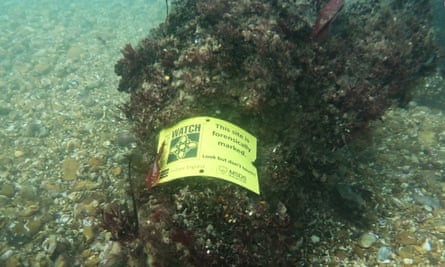Shipwreck treasures that lie on seabeds around the coast of England are to be given “gamechanging” protection against criminals.
Historic England has announced details of a scheme that will involve, for the first time, forensic marking at some of the 57 most protected wreck sites.
They include the 17th-century Dutch warship, the Klein Hollandia, which was damaged in 1672 after a skirmish with the Royal Navy off the Isle of Wight and sank with Dutch and British sailors on board in waters off Eastbourne.
The hope and expectation is that the protective marking will act as a deterrent to would-be thieves.
“It’s not visible to the naked eye and that is really important,” said Hefin Meara, a marine archaeologist at Historic England. “The key thing is that it is highly transferable so if you were to go down and start poking around and lifting things up it will be transferred on to the diver’s gloves or straps if things are lifted up.”
The 57 shipwrecks with the highest level of protection in England include the remains of the UC-70 off the coast off Whitby in North Yorkshire, a German minelaying submarine that sank 33 allied ships during the first world war before it was bombed in 1918.

Other wrecks are the Iona II, a paddle steamer which started life as a ferry on the Clyde and was in 1864 on its way to America to be used as a Confederate blockade-runner during the American civil war. It foundered east of Lundy during foggy weather.
The Klein Hollandia, one of the protected wreck sites named as getting new protection, was only definitively identified earlier this year, previously referred to as the “Unknown Wreck off Eastbourne”.
It was built in 1654 and was involved in all major battles in the second Anglo-Dutch war . It was captured by the English during an attack on the Dutch Smyrna convoy in 1672 but was too damaged to avoid sinking.
The wreck has many stories to tell but any thefts or amateur investigation could cause irreparable damage, said Meara.
“It’s not just the artefact you lose, it is all that potential for knowledge and learning and education. When things are taken there is also a potential side-effect of causing additional damage to things like a wooden hull structure.”
The new technology had been eight years in the making, Historic England said.
It is similar to the forensic marking that might be used on church roof lead which has, over the years, been systematically targeted by gangs for its scrap value. The big difference is that it has to be applied under water by divers.
The announcement is being made in what is the 50th anniversary year of the Protection of Wrecks Act 1973.
As well as the 57 sites with the highest protection, there are about 6,000 wreck sites which experts know the location of, and then more than 30,000 others that haven’t been found. “But we know they are out there,” said Meara.
There is a romance which comes with shipwrecks. “It is a cliche but it’s true, they are time capsules and because we know where they’ve come from, we know the exact day they were lost, there is so much they can tell us,” said Meara.
“The stories are endless. You’ve got international trade, relations between nations, fascinating insights into different kinds of technology and how ships were built and repaired and modified. And then there are the personal stories when you find objects which belonged to individuals.”
Alison James, the heritage and systems manager at the specialist archaeological contractor MSDS Marine, said the protective marking project “is a gamechanger for maritime archaeology and how authorities protect sites underwater”.
